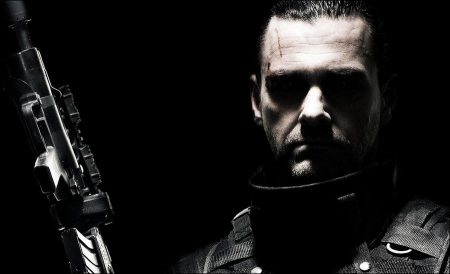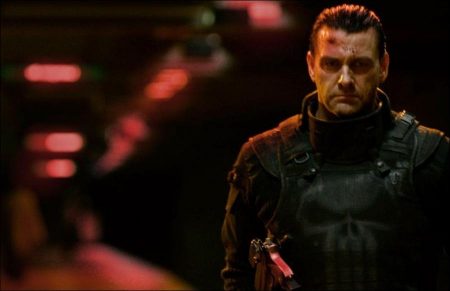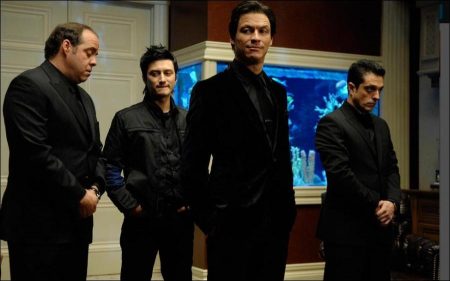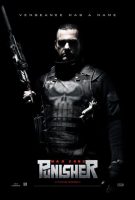Tagline: Vengeance has a name.
Punisher: War Zone movie storyline. Waging his one-man war on the world of organized crime, ruthless vigilante-hero Frank Castle sets his sights on overeager mob boss, Billy Russoti. After Russoti is left horribly disfigured by Castle, he sets out for vengeance under his new alias: Jigsaw. With the “Punisher Task Force” hot on his trail and the FBI unable to take Jigsaw in, Frank must stand up to the formidable army that Jigsaw has recruited before more of his evil deeds go unpunished.
When Frank Castle first appeared as the Punisher in the Marvel comic Amazing Spider-Man #129 in 1974, the character took the comic book world by storm, ushering in a new era of anti-hero. Reflecting the growing moral unease and cynicism of post-modern America in the late 1970s and 1980s, the Punisher complicated the simple dynamics of good versus evil that had previously dominated comic book storytelling for decades.
Here was a bloodthirsty ex-Marine driven by rage over the deaths of his family at the hands of the mob, not a superhero, but a mortal man with extraordinary skills and unflagging determination, one who dispenses his own brand of justice – involving murder, torture and violence – to the corrupt. Twenty-five years later, the Punisher is still a fan favorite, having born multiple comic series and film adaptations. Now, Lionsgate, written by Nick Santora and Art Marcum & Matt Holloway, director Lexi Alexander, producer Gale Anne Hurd and Marvel have fashioned a gritty, violent, absolutely faithful film adaptation of the Punisher, inspired by the hard-edged, groundbreaking Punisher Max series created by Garth Ennis in 2004.
“The great thing with comic books, especially a comic book like the Punisher series, is that there are so many incarnations of the character,” reports producer Gale Anne Hurd. “In this case we had an opportunity to deal with a very dark and violent story. We didn’t have to make it light. We could really examine the tortured psyche of Frank Castle.”
Fans of the Punisher have already seen two similarly named film adaptations of the vigilante hero, Mark Goldblatt’s 1989 version starring Dolph Lundgren, and Lionsgate’s more recent 2004 entry, a pared-down actioner starring Thomas Jane and John Travolta. Alexander states that her version of the Punisher story embraces the look and tone of the Punisher Max series and writer Garth Ennis’ re-envisioning of the Punisher. She says, “This is its own film, with a different script, a different filmmaker, a different look, a different cast, a different hero. It’s really not comparable.”
Punisher: War Zone depicts Castle wrestling with the eternal questions of good and evil and the repercussions of his contradictory moral code. Explains Hurd, “Frank Castle sets out to eliminate an entire Mafia group that has killed an innocent man. As a result, he finds something that he never expected: that in the process of punishing the guilty, he’s actually killed an innocent man himself. So during the course of the story, he not only has to wrestle with that, but he has to take on Jigsaw, the most fearsome villain that he’s ever encountered, who he had a hand in creating.”
“Frank’s the final solution in some ways, the final arbiter of justice,” says co-producer Jack Murray. “He is a take action kind of guy. He doesn’t ask questions, doesn’t take names and numbers. When he sees something that needs to be fixed, he fixes it.”
“At the same time, this guy is a man’s man who is incredibly sad, incredibly scarred,” offers Alexander. “He’s very dark and it’s very questionable whether he’s on the good side or on the bad side. I think that’s what really fascinates me because it’s not all about action and super powers. It’s about this guy and where his soul is.”
Lexi Alexander’s previous directing work includes a drama about soccer hooligans in London entitled, Green Street Hooligans (2005), as well as a short film, Johnny Flynton, which was nominated for an Academy Award. “It was very flattering for the studio and Marvel to come to me because I’m young, I come from the independent film world and I have never done a studio film,” says the director. “It’s been incredibly exciting working on something that has such a huge following.”
Initially, however, Alexander was unsure whether she was an appropriate choice for a comic book adaptation – that is, until she read the Punisher Max series. “I really reacted to the mythology of Frank Castle,” she says. “He’s a guy whose heart just darkened and who basically thinks he can only save the world by killing everybody who’s bad. And that’s just right up my alley. I thought, `All right, I can do a good job with this.’”
“Lexi is a visionary,” says Hurd, “and her passion and perspective are contagious. She just believed so much in how this movie could look and she wanted to attract a high caliber cast. I’m really excited to have her at the helm of this project.”
British actor Ray Stevenson (HBO’s “Rome”) admits that he was challenged by the moral complexities of Castle’s actions, and he still maintains that the Punisher is not a role model to be emulated, but a warning. “There is a kind of nihilism to his actions,” says the actor. “He doesn’t set himself up as a protector of the innocent, he’s a punisher of the corrupt. That’s a very clear line to draw. He knows he can’t right the world. He knows he can only do this one bit. But at least, for him, it’s the one bit he can do.”
Stevenson believes Castle remains sympathetic because he hasn’t lost his humanity. In fact, Castle is often all too human. “He hasn’t got super powers or lightning bolts shooting out his eyeballs or anything like that,” he says. “He uses skills he’s learned to get his job done. I think people also identify with his personal story as a man who suffered a tremendous tragedy in his life and decided on a route of vendetta, a vigilante attitude that says that once people cross a certain line, they’re beyond redemption.”
Adds Alexander, “What I would say is unique about this Punisher is that you’ve got a great actor playing the part, Ray Stevenson. There is gravitas and a sense of sorrow to his task, and along with the action there is a heart, one that’s been beaten down but is still there.”
Dominic West (HBO’s “The Wire,” 300, Hannibal Rising) relished the chance to play the villain, Billy “Jigsaw” Russoti, a vain mobster whose run-in with the Punisher results in a gruesome accident in a glass crusher that leaves him horribly disfigured. He recalls, “When I read the part, I instantly got excited about it because he gets to be the most vain man in the world who then gets smashed up and becomes the most evil man in the world.”
West describes Jigsaw as “absolutely amoral, disinterested in everything except what he needs at that moment, whether he has to kill someone or get his money or whatever. He’s a total psychopath.” West sat in the make-up chair for two hours every day for the necessary application of prosthetics, masks and wigs. “We wanted to come up with something that was different than what’s in the comic book,” explains visual effects supervisor Robert Short. “What plays in comic books doesn’t usually play onscreen. We had to come up with something that was much more sophisticated.”
While he didn’t enjoy the hours in the makeup chair, West did appreciate the benefits of working with most of his face covered. “It’s very liberating to wear a mask,” he says. “It means that you’re not hampered by naturalism or even one’s own looks. One can be fully a different character, and I suppose that’s always what excited me about acting.”
Angela and Grace, played by Julie Benz and Stephanie Janusauskas respectively, play a vital role in the film as the wife and daughter of the FBI agent the Punisher mistakenly kills. In their presence, Frank wrestles with his guilt while also being reminded of the emotional familial ties he once had and lost. “Frank’s a loner and he’s on his mission. Showing emotions is not what he does while he’s out killing bad people,” explains Alexander. “So here comes this little girl and he has no guard for that kind of innocence. To me, the best moments in the film are when he just breaks down. There’s just nothing he can do, there’s no wall he can have up against this little girl.”
Benz (Showtime’s “Dexter,” Rambo 2008) explains that part of the appeal of playing Angela Donatelli was the opportunity to step outside of gender stereotypes. “Angela is a woman who has a little bit more of an edge, who’s a little bit tougher,” she says. “She’s not just the damsel in distress who needs to be rescued. She’s willing to kill someone to save her child.”
Benz also enjoyed exploring the complexities of Angela’s relationship with Frank. She says, “Angela has a lot of anger towards him for killing her husband. She does think he’s a very dangerous man but at the same time she has to rely on him for protection and to protect her daughter. And I think there’s an understanding of pain between the two of them, this loss of a spouse.”
Agent Paul Budiansky, the FBI agent who hunts down Castle in order to avenge the death of his partner, who Castle killed, contributes yet another layer of moral complexity to the story. Budiansky is committed to putting Castle behind bars, until the FBI makes a deal with the very murderers his partner died trying to bust. “Therein lays the quandary,” explains actor Colin Salmon (Match Point, Alien Vs. Predator, Die Another Day). “The murderers are released, which throws my character into a serious moral debate. I start to gravitate toward Frank Castle’s philosophy, to actually help him. I come to understand that there are certain things outside of law that need to be done.”
Budiansky teams up, despite his reservations, with Detective Soap, played in the film by Dash Mihok (The Day After Tomorrow, The Perfect Storm, Romeo & Juliet). A behavioral psychologist who has been tracking the Punisher for years, Soap plays the bumbling fool, though his soft-headed act helps hide a more cunning side. “I was really attracted to the opportunity to offset all the action with some humor,” says Mihok. “Soap’s really kind of socially inept and odd but there’s something about him that most people don’t know. He has two sides, and that dichotomy is really fun to play.”
Linus “Microchip” Lieberman, played by comedic actor Wayne Knight (Jurassic Park, “Seinfeld,” Toy Story 2, Basic Instinct), continues the tradition of the superhero confidant established by the likes of Batman’s Alfred and James Bond’s Q. Linus provides weaponry for the Punisher as well as moral support and an intimate knowledge of Castle’s psychological demons. “Even though he’s involved in vigilante justice,” says Knight, “Linus is a highly moral guy. He’s not a man of action: he facilitates action.”
The last lead role in the cast is the only one that doesn’t exist in the Punisher Max series. Loony Bin Jim is Jigsaw’s brother, a mentally ill man freed from an insane asylum to wreak havoc on the Punisher and arguably the most deranged villain in a film teeming with psychopaths. “It’s fun to play a cartoon character because you can do anything you want. You can bump it up a little bit,” says actor Doug Hutchison (“CSI,” “Law & Order”, I Am Sam). “I shaved my head and really got a visual of this character. Throughout the course of the film, my medication is wearing off. I decided that it would be fun to try to create this arc so that when you first meet LBJ, he’s very focused and still, soft almost, but dangerous. As the film progresses, little by little, he starts to deteriorate physically and mentally so that by the end of the movie, when he has this incredibly insane fight with the Punisher, he’s just a rabid madman unleashed.”
Hutchison and West also enjoyed forging a disturbingly intimate relationship between their on-screen characters. “There’s this intense brotherly love between us, we’ll do anything for each other,” says Hutchison. “We tried to find windows of opportunity to show how much we love each other. It’s a little disconcerting because we’re these monsters and yet, when we’re together, it’s gentle hugs, consoling and supporting each other. It’s an almost emotionally incestuous relationship.”
During production, Alexander and her design team made every effort to re-create the look of the graphic novel, settling on a color-saturated aesthetic that mimics the bold colors of the Punisher Max comic. “We were able to visually embrace the Punisher Max series in terms of the dark, really intense and violent world that the Punisher inhabits,” explains Hurd. “It was very important to Lexi Alexander, our DP Steve Gainer, production designer Andrew Neskoromny and costume designer Odette Gadoury to really bring those comic book frames to life. That was something that we worked very hard to achieve with the film.”
“At times, it was almost a color of emotion, depending on what’s happening in the scene,” explains production designer Andrew Neskoromny. “Violence would be, of course, reds and oranges, and other moments that were more somber were cooler, blues and greens.” Director of photography Steve Gainer avoided realism whenever possible, using a series of filters and gels to create a vibrant, graphic style. “We did several weeks of testing before we shot the film, where we basically went through the color gels that seem to match the colors of the comic,” says Gainer. “I even spoke to one of the colorists from the Ennis series to make sure we got it right.”
“I think the fans can look forward to a far more visceral interpretation of the actual comic books,” says Murray. “Everything down to the palette being used to the locations and the characters are drawn directly from the comics. They are not caricatures. They are actually characters inhabiting this dark, gritty, urban, sodium-lit world of neon lights and atmospheric, heightened shadows.”
Additionally, Hurd solicited design advice from famed comic book artist Tim Bradstreet, who is responsible for some of the best art in the Punisher series. The writers also peppered the script with references to the original comic as a shout-out to diehard fans. A hotel in the film, for instance, was named the Bradstreet Hotel, after the artist. The Punisher’s iconic skull was also a crucial element of the visual design. “When I did the artwork and design for the skull, I wanted to create something that was more like a bulldog, more stocky, more just pure bulk and strength to kind of go along with Ray,” explains Neskoromny.
One of Hurd’s priorities was to ensure that the action sequences in Punisher: War Zone were as punchy and original as possible. “It was really important for us to keep it fresh and interesting and to do something that people have never seen before,” says Hurd. “We have action on the street, we have hand-to-hand combat, and we have the most exotic, interesting and amazing gunplay that you can imagine. We have innovative scenes where Frank Castle, as the one-man Punisher army, takes on twenty or thirty people. We have free-running action, rooftop fights, sequences that take place throughout every imaginable urban setting.”
Alexander, whose professional career began first as a professional martial arts competitor, and later as a stuntwoman for Hollywood films, worked carefully with longtime friend, stunt coordinator Pat Johnson, to create fight sequences that were faithful to the feel of the comic book. “There’s nobody more qualified to do this film than she is,” Johnson avows. “It’s one thing to tell the story but Lexi knows what it’s like to be in a head to head fight because she’s a fighter herself. She understands fighting. She’ll say, `Let’s change that kick. That looks too much like a martial arts film. Let’s do something else.’ She knows what she wants, for which I will make the adjustment, and 100% of the time she’s been right. This film probably has the most realistic, brutal fights of any that I’ve ever done in my thirty-five years in film.”
Not all the choreography involves violent combat, however. Audiences will be amazed by Jigsaw’s band of hired thugs, lead by TJ Storm’s character, Maginty, who all move with the signature dexterity of `free-runners.’ Widely known as parcour, free-running is an extreme sport that was born in the urban, industrial areas of Paris. The sport essentially re-imagines any environment as a massive jungle gym, with practitioners acrobatically running, jumping and climbing up and down buildings, walls and stairwells without any safety ropes. “Parcour is a sport that requires you to be really agile, able to jump over things, flip over walls and all of that kind of stuff,” says Storm. “My martial arts background really helped me in this movie.”
“I think one of the things that the die-hard comic book fans can look forward to with this film is the absolute dedication of Ray Stevenson, who looks like he came right from the comic book pages,” says Hurd. “I have never seen anyone work as hard as Ray Stevenson did.”
Stevenson, who had no previous fighting experience, spent months before production training for his role. “We had quite a bit of time to train him,” says Johnson. “We worked five hours a day, six days a week. Ray actually lived at my home in California, so that I could be sure that he was going to be out by five o’clock in the morning to start training at 5:30 a.m.” Endurance was one of the prime objectives, as Stevenson faced weeks of twelve-hour days in which he was performing nothing but stunts and hand-to-hand combat.
Not simply satisfied with achieving a high level of fitness, Stevenson also trained with military advisor Jon Barton, who taught him how to handle and fire a vast array of weapons, as well as how to move like a man with military training. “Part of what makes a military man stand out is his ability to move through buildings and open areas. It’s very distinct, and it takes practice,” explains Barton. “We did a lot of work with weapons: transitioning from a rifle to a pistol, using two pistols, using two pistols and a rifle, grenade launchers and rocket launchers. After six weeks, we started doing what we call force-on-force, which is where I had Ray engage my fellow employees in mock battle sequences where he would be the Punisher and he would have to kill everybody, and they had to try to kill him. That was really fun because it gave him a chance to be shot at.”
“In some cases we have thirty-five people in one scene fighting, battling each other, probably eighteen against eighteen people,” explains Johnson. “We had an entire floor of an old college dorm, explosions, the use of all sorts of weapons, grenades, rocket launchers, everything. The audience will never have seen anything, as far as fighting and war combat, in a film before. They will never have seen it on screen. I promise you.”
While the film certainly aims to please die-hard Punisher fans, Murray believes Punisher: War Zone will undoubtedly attract new audiences as well. “I think that the Punisher is an appealing character because he’s flawed. With a lot of superheroes, there’s right and wrong, but Frank lives in a grey area. He’s a character that sees injustice but actually corrects it with an injustice. A little bit of doing the wrong thing is ultimately right.”
“I think audiences are going to see this film as a morality tale, a very exciting movie that is challenging in a way,” offers Knight. “It is not a kiddy take on the violence of crime and payback.”
“It’s an R-rated film so we don’t pull any punches,” adds West. “There are levels of nuance. There’s parody and irony. There’s satire on things like the vigilante hero, the American health care system and certainly, as played out in my character, recruiting people for the Army. I think there’s a lot of grown up humor in it.”
Hurd is confident that the filmmaking team, with the help of Marvel and Lionsgate, has created something unique. “Punisher: War Zone is an intense, exciting, action-filled, very violent ride that is an opportunity for audiences to see the Garth Ennis-style Punisher on screen with all the colors and all the action that they expect. They’re actually going to experience what they see in the comics.”
“It’s the graphic novel come to life,” adds Alexander. “If you love the graphic novel, then Punisher: War Zone is really going to be exciting for you. If you have no knowledge of it, I think you’ll have a very entertaining ride anyway, one that brings you into a very surreal world but still has characters you can relate to.”
Punisher: War Zone (2008)
Directed by: Lexi Alexander
Starring: Ray Stevenson, Dominic West, Doug Hutchinson, Colin Salmon, Wayne Knight, Dash Mihok, Julie Benz, Stephanie Janusauskas, Mark Camacho, Keram Malicki-Sánchez
Screenplay by: Nick Santora, Kurt Sutter, Matt Holloway, Art Marcum
Production Design by: Andrew Neskoromny
Cinematography by: Steve Gainer
Film Editing by: William Yeh
Costume Design by: Odette Gadoury
Set Decoration by: Suzanne Cloutier, Michel Clément, Annika Krausz, Andrew Law, François Sénécal
Art Direction by: Martin Gendron, Jean Kazemirchuk
Music by: Michael Wandmacher
MPAA Rating: R for pervasive strong brutal violence, language and some drug use.
Distributed by: Lionsgate Films
Release Date: December 5, 2008
Views: 112






